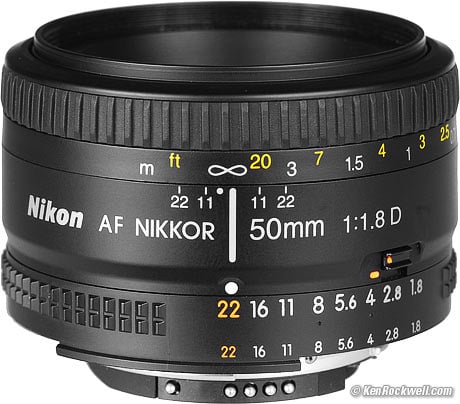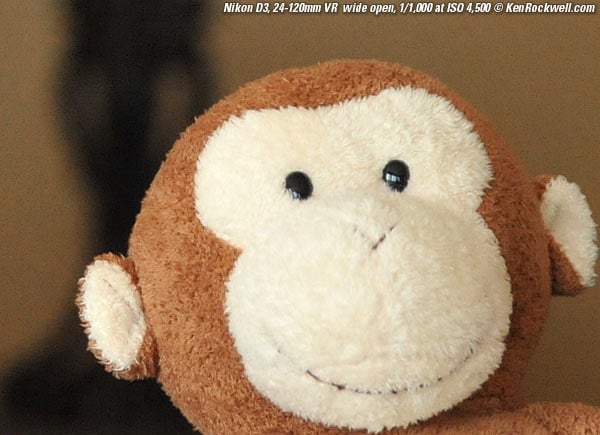Home Search Gallery How-To Books Links Workshops About Contact
Fantastic High ISO Performance for $120! Nikon AF 50mm f/1.8 D. I'd get mine at Adorama, Amazon or Ritz. It helps me keep adding to this site when you get yours through these links, thanks! Ken. July 2008 More Nikon Reviews More Canon Reviews Introduction
My Nikon D3 with a zoom like the 24-120 VR doesn't do much in dim light. It still has to push itself to crazy ISOs that look nowhere near as good as the same shot made with a faster fixed lens. Photographers spend thousands of dollars on cameras like the $5,000 D3, $3,000 D700 and $1,900 Canon 5D just to get "good high-ISO performance," when they could have spent a couple of hundred dollars instead on a better lens that would let a much cheaper camera outperform it. That same improved lens on one of these expensive camera will do wonders compared to a zoom in dim light. What photographers really want is the ability to make great shots in dim light, but then get hung up on worrying about the wrong specifications. How well a camera works at ISO 3,200 is only a fraction of the low-light equation. At least as important as the camera is how much light is collected by the lens. If the lens gathers more of the subject's light, the camera can work at a lower ISO for the same shutter speed in the same lighting. Most casual photographers use zoom lenses, which are great in daylight, but a huge handicap in the dark without flash. A typical zoom lens is about f/3.5 to f/5.6. That's great for daylight, but the camera needs to start inching up its ISO even in moderate light. A $1,500 professional zoom is f/2.8. This gathers more light, but still only a fraction as much light as even the cheapest fixed normal lens. A $120 fixed f/1.8 lens, like the one above, gathers many times more light than a zoom. If you pay $3,600 for the D700/24-120mm VR combo, the 24-120mm lens is only about f/5.6 in the 50mm range. f/1.8 is 10 times more sensitive to light than f/5.6. The D700 will have to be at ISO 6,400 to get the same picture with the same exposure time as a D80 with an f/1.8 lens at only ISO 640! I've been astounded at how my low-light photography has improved by using a fast lens in low light, instead of any zoom, even the f/2.8 versions. Regardless of your camera, if you're concerned with low-light no-flash photography, you owe it to yourself, and maybe to your own wallet, to get a fast lens and see what happens. Math Refresher You can skip ahead if you know this, but for those who've forgotten math class, this is important to understanding just how important the right lens is for shooting action in dim light. An f/stop refers to the open diameter of a lens. It's a fraction. f/2 means the open hole on the front of the lens is f/2 in diameter. For a 50mm lens, f is 50mm, so f/2 means 50mm/2, or 25mm. F/4 means the open hole in the glass is 50mm/4, or 12.5mm. Light comes in based on the area of open glass, as controlled by the black diaphragm blades or size of the glass. Area varies as the square of the diameter, so every time the f/stop number changes by 1.4, the amount of light coming through doubles or halves. (1.4 squared = 1.4 x 1.4 = 2.) This is why f/stops go in the sequence f/1.4, f/2, f/2.8, f/4, f/5.6 etc. Each step is double or half the next. If you go two or three stops, you get two or three doublings or halvings, so two or three stops is a change of 4x or 8x (2x2 or 2x2x2). (If you want to work in half or third stops, you want to work in base 2 logarithms, or simple square the ratios of the f/numbers.) Thus, f/1.8 is three and one-third stops faster than f/5.6, or lets in ten times the light. An f/1.4 lens lets in 16 times the light as an f/5.6 lens.
Fast Lens Suggestions About $100 For $120, get the Nikon 50mm f/1.8 D or the $85 Canon EF 50mm f/1.8. About $300 My favorite is the Nikon 50mm f/1.4 D. Want to see what it does? See my photos of my kid Ryan. Canon also makes the Canon EF 50mm f/1.4. Also try the Nikon 35mm f/2 D and Canon EF 28mm f/1.8 and EF 85mm f/1.8. About $1,000 Canon 24mm f/1.4, 35mm f/1.4, 50mm f/1.2 and 85mm f/1.4 About $3,000 Sadly, Nikon discontinued the spectacular 28mm f/1.4 D, whose used price has skyrocketed.
Example Nikon D40 vs. Nikon D3. Roll mouse over to compare. These mild crops from the centers of these images look about the same for noise to me, with the D40 a little sharper. At the same ISO, the D3 is far better than the D40. In this case, the faster lens let the D40 shoot at ISO 450 instead of ISO 4,500 and look at least as good as the $5,000 D3. See how the right $120 lens on a $400 camera works as well in dim light as the wrong $600 lens on a great $5,000 camera? Imagine how well the D3 works with the right lens, or heaven forbid, using an f/1.4 lens instead of an f/1.8!
Got chas All the Canon lenses work on every Canon digital and EOS film camera. The cheapest new Nikons (D40, D40x, and D60) can't autofocus with the fast lenses. Everything else works, but you'll have to focus by hand and look in the finder for the correct focus. I used the D40 for the example above because it's Nikon's cheapest camera, but I did have to focus by hand. If you're going to use a fast lens on a Nikon, get anything else, like the D50, D70, D80, D100 or better, like the D200 or D300. Of course they work great on the D700 and D3.
VR VR is a huge help if your subject is holding still. If it is, you can shoot at slower shutter speeds and make up for slower lenses. If your subject is moving, VR is no help.
PLUG I support my growing family through this website. If you find this as helpful as a book you might have had to buy or a workshop you may have had to take, feel free to help me continue helping everyone. If you've gotten your gear through one of my links or helped otherwise, you're family. It's great people like you who allow me to keep adding to this site full-time. Thanks! If you haven't helped yet, please do, and consider helping me with a gift of $5.00. It also helps me keep adding to this site when you get your goodies through these links to Adorama, Amazon, B&H, Ritz, and J&R. I use them and recommend them all personally. Thanks for reading!
Ken |
Home Search Gallery How-To Books Links Workshops About Contact





